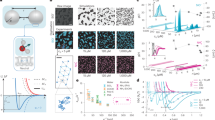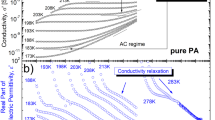Abstract
IN a previous communication in Nature 1, I suggested that the short-range equilibria which have been proved to occur between montmorillonite lamellæ might be ascribed to electrical attractive forces due to a ‘crystalline’ layer of interlamellar cations, these forces being balanced by repulsive forces due to adsorbed layers of oriented molecules. The phenomenon is unlikely to be confined to montmorillonite. It is therefore of general interest to consider how such an arrangement might pass into the normal diffuse Gouy layer distribution as the separation between the lamellæ increases.
This is a preview of subscription content, access via your institution
Access options
Subscribe to this journal
Receive 51 print issues and online access
$199.00 per year
only $3.90 per issue
Buy this article
- Purchase on Springer Link
- Instant access to full article PDF
Prices may be subject to local taxes which are calculated during checkout
Similar content being viewed by others
References
MacEwan, D. M. C., Nature, 162, 935 (1948).
Madelung, E., Phys. Z., 19, 524 (1918).
Verwey, E. J. W., and Overbeek, J. Th., “Theory of the Stability of Lyophobic Colloids” (Elsevier, Amsterdam, 1948).
Norrish, K., Nature, 173, 256 (1954).
Author information
Authors and Affiliations
Rights and permissions
About this article
Cite this article
MACEWAN, D. Short-range Electrical Forces between Charged Colloid Particles. Nature 174, 39–40 (1954). https://doi.org/10.1038/174039b0
Issue Date:
DOI: https://doi.org/10.1038/174039b0
This article is cited by
-
Über quasikristalline Strukturen bei der Flockung von Montmorilloniten und die Ausbildung diffuser Ionendoppelschichten in Nitrobenzol
Kolloid-Zeitschrift und Zeitschrift für Polymere (1972)
Comments
By submitting a comment you agree to abide by our Terms and Community Guidelines. If you find something abusive or that does not comply with our terms or guidelines please flag it as inappropriate.



